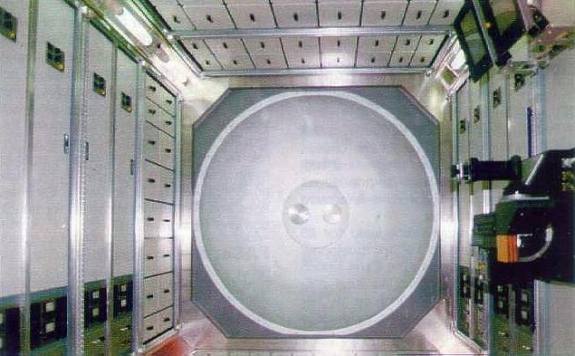
Home - Search - Browse - Alphabetic Index: 0- 1- 2- 3- 4- 5- 6- 7- 8- 9
A- B- C- D- E- F- G- H- I- J- K- L- M- N- O- P- Q- R- S- T- U- V- W- X- Y- Z
ISS MPLM

MPLM
Multi-Purpose Logistics Module - MPLM. Inside the MPLM. The module carries sixteen International Standard Payload Racks.
Credit: NASA via Marcus Lindroos
AKA: MPLM;Mini-Pressurized Logistics Module. Status: Operational 2001.
As NASA's Space Station budget received further cutbacks, the agency was forced to consider more and more hardware paid for by foreign space agencies although Congress and private industry were opposed to it. In 1992, Italy's Alenia Spazio announced they would build a small Mini-Pressurized Logistics Module (MPLM) for the Space Shuttle, enabling it to carry 4500 kg of cargo to the Space Station. The MPLM might also be transformed into a small life sciences laboratory. Boeing had previously wanted to build the MPLM, but NASA could not afford to pay for it. Instead, the Italian space agency, ASI, would now finance the $400-million project in return for crew time and experiments on the Space Station.
The new Multi-Purpose Logistics Module was twice as long and could carry 9000 kg of cargo to ISS. The European Space Agency also became a partner, since Alenia Spazio would use the same pressurized module and some thermal subsystems in the Columbus Orbiting Facility as well. In return, ESA provided three environmental control and life-support system units for use in the Multipurpose Logistics Module. The module carried sixteen International Standard Payload Racks.
Italy delivered the first 'Leonardo' Multi-Purpose Logistics Module to NASA in July 1998. Two more module -- 'Rafaello' and 'Donatello' -- would also be delivered under the $300-million contract. Italian astronauts would receive greater use of the Station as well as crew training for two more ASI astronauts in return for the MPLM.
Article by Marcus Lindroos
More at: ISS MPLM.
Family: Space station module, USA - Space Stations. Country: Italy. Spacecraft: ISS. Agency: ESA, Alenia.
Back to top of page
Home - Search - Browse - Alphabetic Index: 0- 1- 2- 3- 4- 5- 6- 7- 8- 9
A- B- C- D- E- F- G- H- I- J- K- L- M- N- O- P- Q- R- S- T- U- V- W- X- Y- Z
© 1997-2019 Mark Wade - Contact
© / Conditions for Use